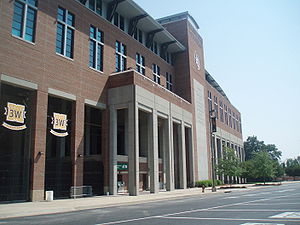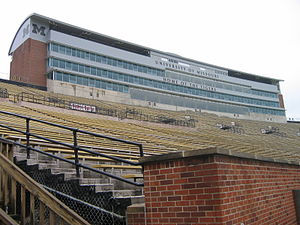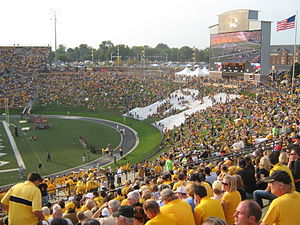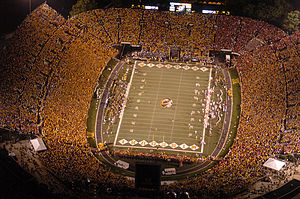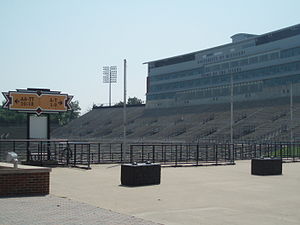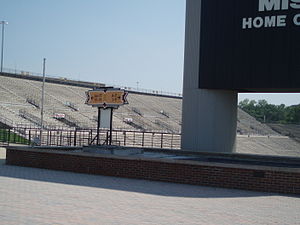- Faurot Field
-
Faurot Field at Memorial Stadium "The Zou" 
Location 600 East Stadium Boulevard
Columbia, Missouri 65201Coordinates 38°56′9″N 92°19′59″W / 38.93583°N 92.33306°WCoordinates: 38°56′9″N 92°19′59″W / 38.93583°N 92.33306°W Broke ground December 9, 1925[1] Opened October 2, 1926 Renovated 1978, 2003 Expanded 1949-1950, 1961-1963, 1971, 1978, 1996, 2003 Owner University of Missouri Operator University of Missouri Surface Grass 1926 to 1984 and 1995 to 2002
Omniturf 1985 to 1994
FieldTurf 2003 to presentConstruction cost $525,000[2]
($6.52 million in 2011 dollars[3])Architect Jamieson and Spearl (original)/Ellerbe Becket (renovation)[4] Capacity 71,004 (2009-present)[5]
68,349 (2003-2008)
68,174 (1996-2002)
62,023 (1978-1995)
51,223 (1971-1977)
47,628 (1963-1970)
44,033 (1961-1962)
35,000 (1950-1960)
30,000 (1949)
25,000 (1926-1948)Record attendance 75,298 Tenants Missouri Tigers (NCAA) (1926–present) Faurot Field (pronounced /fɔːˈroʊ/) at Memorial Stadium is the home field of the University of Missouri Tigers in Columbia, Missouri. It is primarily used for football. In 1972, Memorial Stadium's playing surface was named Faurot Field in honor of longtime coach Don Faurot. During the offseason, soccer goals are set up in the end zones and it is used for intramural matches. It also hosts the annual "Providence Bowl" game between Hickman and Rock Bridge high schools (so named because both schools are located on Providence Road in Columbia, and Faurot is roughly equidistant between the two) and in the past has been home to the MSHSAA football championships, now held in St. Louis (taking advantage of the climate-controlled atmosphere of the Edward Jones Dome). It is the second largest sports facility by capacity in the state of Missouri, second to Arrowhead Stadium in Kansas City.
The stadium is a typical horseshoe-shaped stadium, with seating added on in the "open" endzone. The horseshoe is completed by a grass berm in the curved end, which is used for general admission on game days. The berm is famous for the giant block "M" made of painted white stones located behind the endzone. This distinctive feature has not been immune to pranks, such as enterprising Nebraska or Kansas fans attempting to change the "M" to an "N" or a "K", but groundskeepers and students have in the past protected what may be the stadium's best-known landmark. One of the traditions of the football team is that seniors, after playing their final home game, take a rock from the "M" as a souvenir. It is also traditionally whitewashed every year by incoming freshmen during welcoming activities.
There is road between the field and the stands around the entire length of the horseshoe, taking the place of the track, removed in the mid-1990s.
Contents
Early history
Fundraising began in 1921 for a "Memorial Union" and a "Memorial Stadium" to be constructed at the University. The names of the two projects were a tribute to Mizzou alumni who lost their lives during World War I. Ground was broken on the site of the future stadium in December 1925. The site was a sizeable natural valley that lay between twin bluffs south of the campus. Original plans called for the stadium to seat 25,000, with proposed stages of expansion in capacity to 35,000, 55,000, 75,000 and 95,000. According to legend, a rock crusher and truck were buried during initial blasting, and they still remain buried under the field.
Memorial Stadium was dedicated on October 2, 1926, to the memory of 112 alumni and students who lost their lives in World War I. The 25,000-seat stadium was built with a 440-yard (400 m) track that circled the playing field. That first October game against Tulane was marred by rainstorms that washed out a bridge into Columbia coming from the western side of Missouri. While the game sold out, the field could not be sodded due to the wet conditions. Therefore, a surface of sawdust and tree bark was used, and "the Tigers and Green Wave played to a scoreless, mudpie tie", in the words of sportswriter Bob Broeg. Grass would be installed thenafter until the 1980s.
The highly recognizable rock 'M' of the northern end zone debuted on October 1, 1927, to a 13-6 victory over Kansas State. The monument was built by members of the freshman class using leftover rocks from the original stadium construction. The 90 ft (27 m) wide by 95 ft (29 m) high 'M' has continued to watch over the field and provide seating for fans since that day.
Mizzou earned its largest margin of victory ever at Memorial Stadium on September 17, 2011. Under Coach Gary Pinkel, the Tigers defeated Western Illinois University by a score of 69–0.
Modernization
In recent years, several major renovations have taken place at Faurot Field. During the summer of 1978, the south endzone was enclosed with 10,800 permanent seats, which brought total seating capacity to 62,023.
On May 18, 1985, the project began to convert the natural grass surface to a new artificial surface called Omniturf. The conversion was completed on August 30. Missouri was the last school in the Big Eight Conference to switch from grass to artificial turf. Six of the other seven conference schools switched to artificial turf in the early 1970s, and Iowa State followed suit in 1975 when the Cyclones' new Jack Trice Stadium opened. The first game on the new artificial turf was a 27–23 loss to Northwestern University played on September 14, 1985. The Tigers went on to finish 0–7 at home during the 1985 season. The OmniTurf surface became infamous to Tiger fans as the "lousy field" on which The Fifth Down Game was played on October 6, 1990. Troubles continued on the artificial surface, and in 1992, Big Eight Conference coaches issued a statement that read, in part: "Big Eight Conference football coaches wanted to report that the football field at the University of Missouri is a detriment to the home and visiting teams and takes away from the integrity of the game played on such a field."[6]
On September 18, 1994, The Rolling Stones performed, during their Voodoo Lounge Tour, before 45,000 fans at Memorial Stadium in a concert that raised almost $100,000 for the conversion of the Omniturf surface back to natural grass. The final game on the infamous Omniturf surface was played on November 19 of that same year against the University of Kansas, a 31-14 Kansas victory. Mizzou's all-time record on the Omiturf was a disappointing 20–38–3.
The artificial Omniturf playing surface was removed and replaced with natural grass over the summer of 1995. Legendary Coach Don Faurot put down the last piece of sod as a symbolic gesture. Faurot had helped to lay the sod of the original playing surface in 1926. He died later that year in October, during Homecoming week. As part of the installation of the new playing surface, grass-covered terraces were extended up from the field to the seating area, where they met a new low brick wall that was designed to give Memorial Stadium a traditional college ambiance. The brick wall also honors the greatest figures in Tiger football (including Faurot, Kellen Winslow and Dan Devine) by listing the team's honored numbers on each panel. The first game on the new natural grass resulted in a 28–7 victory for Mizzou over North Texas. The game was also historic as the first game played under permanent lights—previously, night games only were played under temporary lights paid for by television broadcasters, and as part of the renovations four large light stanchions were erected outside each corner of the stadium.
In 1996,[7] the press box was upgraded to a 15-story building containing state-of-the-art facilities for the coaches and media, as well as several executive suites, hundreds of premium club seats and a restaurant. 1997 saw the installation of a video board in the north ("M") end[6] and a refurbishment of the concourses, with new signage and expanded concessions. FieldTurf replaced the natural grass in 2003. In 2005, the south end's antiquated auxiliary scoreboards were replaced with new ones, as well as a second high-definition video monitor.
In 2009, the university installed a new $5 million 30x80 foot north end zone scoreboard with updated video capabilities and new sound system. The new north end zone video board and audio upgrades replaced the current 10 year old equipment.[8] It is presently the third largest scoreboard in the Big 12 Conference, sitting behind Godzillatron at Texas' DKR Stadium and "12th Man TV" at Kyle Field in College Station.
Future projects
Many fans have expressed interest in expanding the south stands to be more uniform with the rest of the stadium, adding features such as bathrooms and permanent food stands in the process. However, this project may be hampered by the fact that the south end is very close to the water table, and that any added construction will run into problems associated with this.
Record crowds
The stadium officially holds 71,004 people. The record attendance for Faurot Field is 75,298 when Missouri hosted Penn State on October 4, 1980.
All-Time Largest Crowds
- 75,298, vs. Penn State, Oct. 4, 1980
- 75,136, vs. Texas, Sept. 29, 1979
- 74,575, vs. Nebraska, Nov. 3, 1979
- 73,655, vs. Alabama, Sept. 16, 1978
- 72,348, vs. Nebraska, Oct. 15, 1983
- 72,333, vs. Colorado, Oct. 18, 1980
- 72,001, vs. Nebraska, Oct. 24, 1981
- 71,291, vs. Oklahoma, Nov. 17, 1979
- 71,096, vs. Colorado, Oct. 28, 1978
- 71,004, vs. Texas, Oct. 24, 2009
- 71,004 vs. Oklahoma, Oct. 23, 2010
- 71,004 vs. Iowa State, Oct. 15, 2011
Largest Crowds Since 1995 (when seating was reduced to 68,174 capacity from 75,000)
For the 2008 season official seating capacity was increased to 68,349.
For the 2009 season official seating capacity was increased to 71,004.- 71,004, vs. Iowa State, Oct. 15, 2011
- 71,004, vs. Oklahoma, Oct. 23, 2010
- 71,004, vs. Texas, Oct. 24, 2009
- 70,049, vs. Nebraska, Oct. 6, 2007
- 68,349, vs. Kansas State, Nov. 8, 2008
- 68,349, vs. Colorado, Oct. 25, 2008
- 68,349, vs. Oklahoma State, Oct. 11, 2008
- 68,349, vs. Nebraska, Oct. 11, 2003
- 68,174, vs. Nebraska, Sept. 25, 1999
- 68,174, vs. Kansas State, Nov. 21, 1998
- 66,846, vs. Nebraska, Nov. 8, 1997
References
- ^ http://news.google.com/newspapers?id=JglKAAAAIBAJ&sjid=aIUMAAAAIBAJ&pg=4706,4439912&dq=missouri+memorial+stadium&hl=en
- ^ http://news.google.com/newspapers?id=dFMrAAAAIBAJ&sjid=-dcEAAAAIBAJ&pg=1386,5960002&dq=missouri+memorial+stadium+architect&hl=en
- ^ Consumer Price Index (estimate) 1800–2008. Federal Reserve Bank of Minneapolis. Retrieved December 7, 2010.
- ^ Faurot Field - ellerbebecket.com - Retrieved October 8, 2009
- ^ Mizzou Football Guide 09 (PDF), p. 5
- ^ a b University of Missouri, Official Athletic Site of the Mizzou Tigers Facilities
- ^ [1]
- ^ "2008 Progress Continues at the Sports Park at MU". Tiger Row. Summer 2008. p19.
External links
Football stadiums of the Big 12 Conference Floyd Casey Stadium (Baylor) • Jack Trice Stadium (Iowa State) • Memorial Stadium (Kansas) • Bill Snyder Family Football Stadium (Kansas State) • Faurot Field (Missouri) • Gaylord Family Oklahoma Memorial Stadium (Oklahoma) • Boone Pickens Stadium (Oklahoma State) • Darrell K Royal – Texas Memorial Stadium (Texas) • Kyle Field (Texas A&M) • Jones AT&T Stadium (Texas Tech)
Football stadiums of the Southeastern Conference Eastern Division Western Division Bryant–Denny Stadium (Alabama) • Razorback Stadium (Arkansas, primary) • War Memorial Stadium (Arkansas, secondary) • Jordan–Hare Stadium (Auburn) • Tiger Stadium (LSU) • Davis Wade Stadium (Mississippi State) • Vaught–Hemingway Stadium (Ole Miss)
Future Kyle Field (Texas A&M) • Faurot Field (Missouri)
College football venues in Missouri Division I
FBSBig 12 Faurot Field (Missouri)
Division I
FCSMissouri Valley OVC Division II GLFC Algood–Bailey Stadium (Missouri S&T)
Mid-America Audrey J. Walton Stadium (Central Missouri) • Bearcat Stadium (Northwest Missouri State) • Dwight T. Reed Stadium (Lincoln) • Fred G. Hughes Stadium (Missouri Southern) • Spratt Stadium (Missouri Western) • Stokes Stadium (Truman State)
Independent Greene Stadium (William Jewell) • Harlen C. Hunter Stadium (Lindenwood) • Plaster Stadium (Southwest Baptist)
Division III UAA Francis Field (Washington)
UMAC Priest Field (Westminster)
NAIA Heart of America Dasta Stadium (Avila) Davis Field (Central Methodist) • Ellison Poulton Stadium (Culver-Stockton) • Greg Mitchell Field (Missouri Valley) • John F. Kennedy Stadium (Evangel)
Arrowhead Stadium • Edward Jones Dome Categories:- 1926 establishments
- American football venues in Missouri
- Missouri Tigers football
- College football venues
- University of Missouri campus
- Buildings and structures in Columbia, Missouri
Wikimedia Foundation. 2010.

